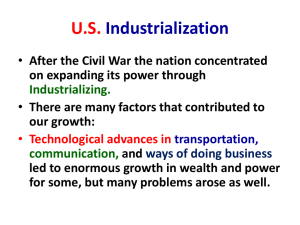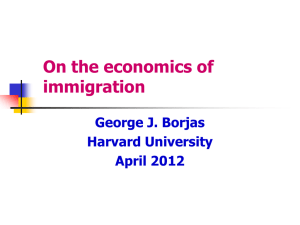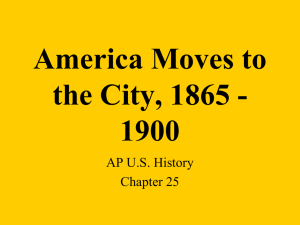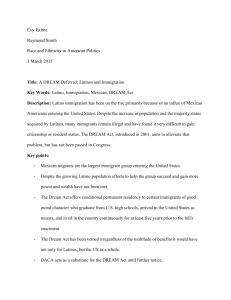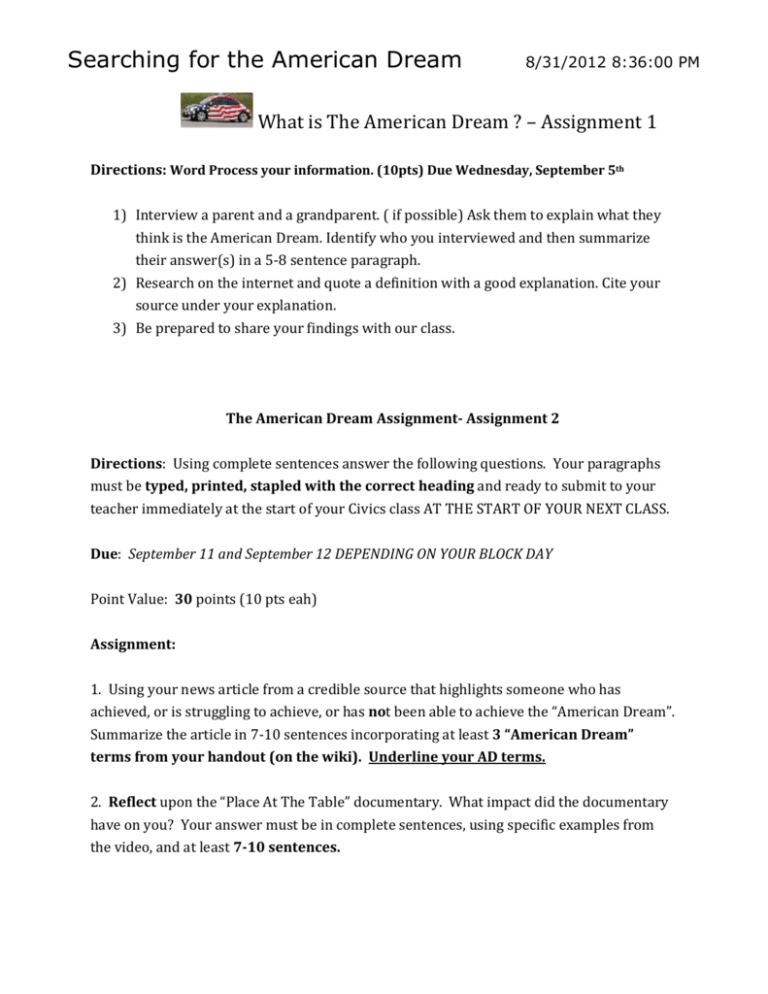
Searching for the American Dream
8/31/2012 8:36:00 PM
What is The American Dream ? – Assignment 1
Directions: Word Process your information. (10pts) Due Wednesday, September 5th
1) Interview a parent and a grandparent. ( if possible) Ask them to explain what they
think is the American Dream. Identify who you interviewed and then summarize
their answer(s) in a 5-8 sentence paragraph.
2) Research on the internet and quote a definition with a good explanation. Cite your
source under your explanation.
3) Be prepared to share your findings with our class.
The American Dream Assignment- Assignment 2
Directions: Using complete sentences answer the following questions. Your paragraphs
must be typed, printed, stapled with the correct heading and ready to submit to your
teacher immediately at the start of your Civics class AT THE START OF YOUR NEXT CLASS.
Due: September 11 and September 12 DEPENDING ON YOUR BLOCK DAY
Point Value: 30 points (10 pts eah)
Assignment:
1. Using your news article from a credible source that highlights someone who has
achieved, or is struggling to achieve, or has not been able to achieve the “American Dream”.
Summarize the article in 7-10 sentences incorporating at least 3 “American Dream”
terms from your handout (on the wiki). Underline your AD terms.
2. Reflect upon the “Place At The Table” documentary. What impact did the documentary
have on you? Your answer must be in complete sentences, using specific examples from
the video, and at least 7-10 sentences.
3. What new information did you learn from the documentary? Explain your answer in 710 sentences using 3 different AD terms than you used above. Underline your AD
terms.
8/31/2012 8:36:00 PM
American Dream
Vocabulary Terms
1. Ageism: aged-based discrimination, typically toward the elderly.
2. Affirmative Action: policies that are put into place in an effort to remedy past acts of
discrimination by ensuring equal opportunities in areas such as education and
employment typically for different minority groups.
3. Anti-Semitism: prejudice toward Jewish people
4. Assimilation: the process whereby a group (such as an immigrant group) gradually
adopts the characteristics or another culture.
5. Ancestor: a person from whom one is a descended. Can be direct or remote.
6. Baby-Boomer: people born after WWII between 1946-1964.
7. Bigot: someone who is intolerant – typically in religion, race, ethnicity, or politics.
8. Controversy: a dispute – typically a public dispute between two opposing views.
9. Civil Rights: individual personal freedoms granted by virtue of their citizenship
status or by simply being a member of a society.
10. Culture: beliefs and ways people adapt to their environment, which are passed
down between generations.
11. Descendant – someone “coming from” an ancestor. Proceeding an ancestor.
12. Discrimination: an action/behavior that excludes all members of a group from
certain activities, rights, opportunities or privileges.
13. Diversity: the fact of being different, varied or unique from others.
14. Deport: to expel a person from a country.
15. Ethnic: a group of people who share a common culture, religion, race or nationality.
16. Ethnocentrism: the belief that one’s own culture or way of life is superior to all
others.
17. Ethnic Cleansing: a systematic elimination of people based upon their ethnicity.
18. Gender: sexual category: male/female groups.
19. Gender Equity: the belief that males/females are equal.
20. Feminism: a belief that the sexes are equal in all categories including social,
political, and economic elements. A political movement originated around this
belief.
21. Minority Group: a minority status that can be based on numerical determination OR
by being a subordinate group whose members have significantly less control/power
over their lives than members of the majority group. Minorities often experience
less socio-economic opportunities than the majority group.
22. Migration: to move from one country/region and settle in another.
23. Immigration: to enter into and settle into a foreign country.
24. Prejudice: a negative attitude toward a category of people.
25. Predilection: a disposition in favor or something. A bias or preference toward
something or someone.
26. Racism: the belief that a certain race is superior to others.
27. Segregate: to separate one group of people from another.
28. Sexism: gender-based discrimination.
29. Scapegoat: someone who is blamed for others.
30. Stereotype: a general image that people hold about a group. Stereotypes are often
negative.
31. Tacit-Sympathy: sympathy implied thru actions…not spoken words.
32. Tolerance: the capacity/ability to respect the beliefs or practices of others.
33. Xenophobia: fear of foreigners.
8/31/2012 8:36:00 PM
8/31/2012 8:36:00 PM
8/31/2012 8:36:00 PM
Info Sheet
American Immigration Timeline
1492:
Columbus reaches the Americas, followed by other European explorers.
1502:
Africans are brought as slaves to the island of Hispanola (present -day Dominican Republic/Haiti) by
the Spanish, with 10 million enslaved Africans to follow and arrive on Ame rican shores.
1607:
First permanent English colony built in Jamestown, Virginia.
1619:
First Africans arrive at Jamestown, Virginia, as indentured servants.
1700-1776:
First big immigrant wave: Europeans, mostly English, arrive in large numbers.
1750:
Population reaches more than one million.
1790:
Population reaches almost four million.
1808:
Congress makes it illegal to bring slaves to the United States.
1820-1870:
Second big immigrant wave: About 7.5 million arrive, mainly from northern and west ern
Europe (especially Great Britain, Ireland, and western Germany).
1840:
Wave of Irish immigrants arrives, escaping famine because of potato crop failure.
1848:
Discovery of gold results in Chinese and Latin American immigrants coming to the west coast .
1881-1920:
Third big immigrant wave: Nearly 23.5 million arrive, mainly from southern and eastern Europe
(especially Austro-Hungary, Italy, and Russia).
1882:
Chinese Exclusion Act is passed to prevent Chinese workers from immigrating.
1886:
Statue of Liberty is unveiled.
1892:
Ellis Island opens.
1900:
Population reaches 76 million.
1907:
One million immigrants pass through Ellis Island in one year.
1914:
World War I inspires strong anti -immigration feelings.
1917:
Congress requires immigrants to pass literacy tests.
1924:
Congress limits number of immigrants by nationality, including southern and eastern Europe.
1930-1964:
Immigration declines due to restrictive laws, the Great Depression, World War II, and the Cold War.
1945:
Puerto Ricans be gin to arrive in large numbers.
1954:
Ellis Island closes, marking an end to mass immigration.
1965:
Immigration Act of 1965 ends quotas (number limit) based on nationality. Immigration from Asia and
West Indies increases.
1986:
Immigration Reform and C ontrol Act forbids hiring of illegal immigrants; helps them become legal
immigrants.
Lesson Connection: Immigrating to America
Copyright The Kennedy Center. All rights reserved.
ARTSEDGE materials may be reproduced for educational purposes.
8/31/2012 8:36:00 PM




